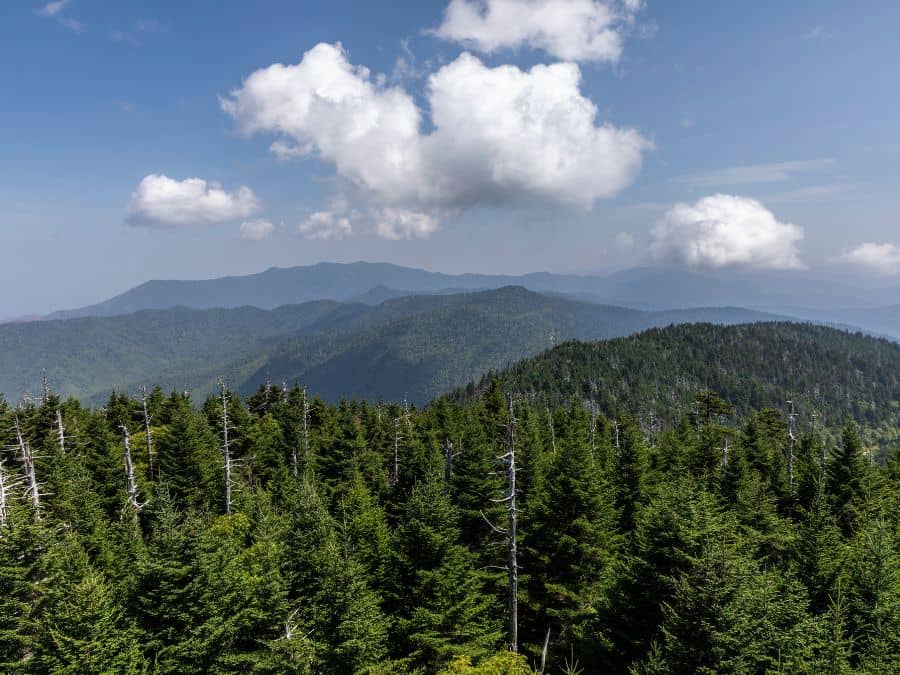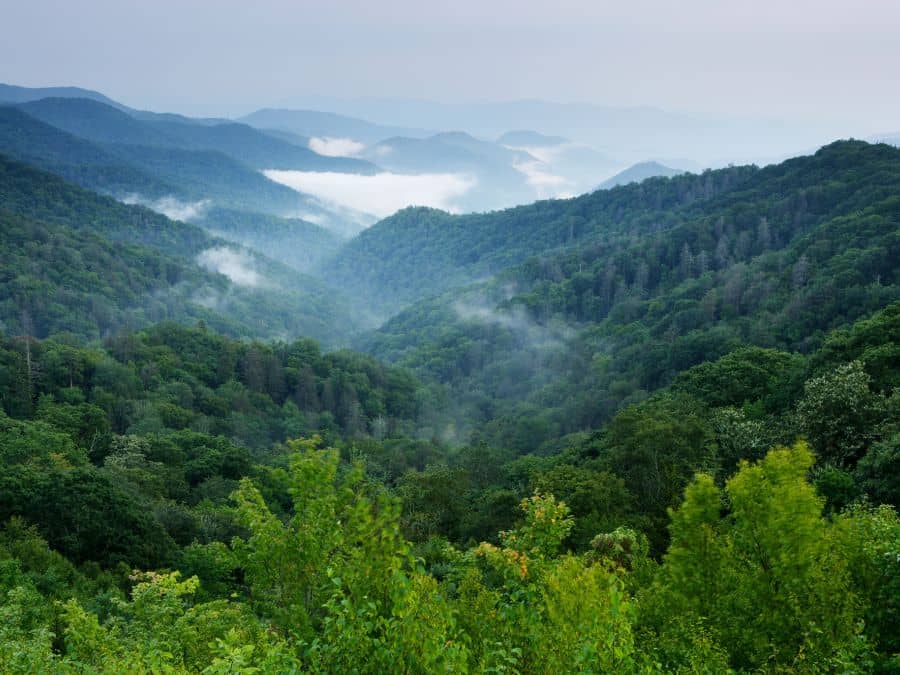A Look at the Smoky Mountains Biodiversity hotspot in North Carolina
Picture yourself standing at the edge of a vast, lush forest, surrounded by towering peaks that disappear into the clouds. The air is crisp and clean, carrying with it the sweet scent of wildflowers and pine trees.
This is just a taste of what you can expect to experience in the Smoky Mountains, one of North Carolina’s most precious treasures. More about What Are The Best Dog Parks In Charlotte, NC?
The Smokies are not only breathtakingly beautiful; they are also a biodiversity hotspot, home to an incredible range of plant and animal species found nowhere else on Earth.
From black bears to salamanders and rare orchids to towering hemlocks, the Smokies offer a unique glimpse into nature’s diversity and complexity.
In this article, we will take a closer look at what makes the Smoky Mountains so special and explore some of its most fascinating features.
So grab your hiking boots and get ready for an adventure like no other!

Overview of the Smoky Mountains
You’ll see that the Smoky Mountains is a stunningly diverse area with an abundance of flora and fauna. With over 100 species of trees, 4,000 plant species, and countless animal species, it’s no wonder why this region has been designated as a biodiversity hotspot.
The Great Smoky Mountains National Park alone has over 800 miles of hiking trails where visitors can witness the natural beauty firsthand. Additionally, there are numerous scenic drives throughout the park which offer panoramic views of the mountain range.
The Smokies is home to several distinct ecosystems which contribute to its remarkable diversity. From lowland forests to high elevation spruce-fir forests, each ecosystem supports a unique set of plant and animal life. Some notable species found in the Smokies include black bears, elk, white-tailed deer, wild turkey, salamanders and over 200 bird species.
Whether you’re an avid hiker or prefer a leisurely drive through scenic roads, there’s no shortage of things to see in this biodiverse haven.

Flora and Fauna of the Smoky Mountains
There’s no denying how breathtaking the variety of wildflowers and animals are in this incredible region. With over 1,600 species of flowering plants, including rare orchids and trilliums, the Smoky Mountains is a mecca for plant enthusiasts.
The biodiversity doesn’t stop there – the area is also home to hundreds of animal species including black bears, elk, white-tailed deer, bobcats, and coyotes.
Unfortunately, some of these species are threatened by invasive plants like Japanese knotweed and kudzu that can outcompete native flora. Additionally, several animals such as the Indiana bat and Carolina northern flying squirrel are endangered due to habitat loss.
Conservation efforts are underway to protect these important ecosystems so future generations can continue to admire the beauty of the Smoky Mountains’ flora and fauna.

Geology and Climate of the Smoky Mountains
If you’re exploring the Smoky Mountains, it’s crucial to understand the geology and climate of the area. The mountains were formed millions of years ago due to tectonic activity, which caused large plates of rock to shift and collide. Over time, these collisions created a chain of rugged peaks that we now know as the Smokies.
The rocks in this region are primarily sedimentary, meaning they were formed from layers of sediment that accumulated over time. When it comes to weather patterns in the Smoky Mountains, visitors should be prepared for both hot summers and cold winters.
During summer months, temperatures can reach up into the 80s°F (27°C) during the day but drop significantly at night. In winter months, temperatures can dip below freezing with snowfall being common in higher elevations. Rain is also common throughout the year with thunderstorms being most prevalent during summer months.
Understanding these weather patterns is important for planning outdoor activities such as hiking or camping in order to stay safe and comfortable while enjoying all that this beautiful region has to offer.

Threats to Biodiversity in the Smoky Mountains
To understand the threats facing the diverse species in the Smoky Mountains, it’s important to recognize how human activities have impacted the delicate balance of ecosystems.
Human impact has caused declines in populations of several species, including the northern flying squirrel. Deforestation and habitat destruction have reduced their numbers as they rely on intact forest habitats for survival.
Invasive species are another significant threat to biodiversity in the Smoky Mountains. These non-native plants and animals can outcompete native species for resources and disrupt entire ecosystems.
For example, Japanese knotweed is a highly invasive plant that can quickly colonize an area, choking out native vegetation and altering soil chemistry.
The introduction of invasive species often occurs due to human actions such as accidental or intentional introduction for landscaping or agricultural purposes, further highlighting our responsibility to protect these unique habitats.
Conservation Efforts in the Smoky Mountains
You can witness the ongoing conservation efforts in the Smoky Mountains through guided hikes and educational programs offered by park rangers. They work tirelessly to restore habitats and protect endangered species.
The Great Smoky Mountains National Park is committed to preserving biodiversity through community involvement and sustainable tourism practices. One example of this commitment is the implementation of a program called ‘Leave No Trace.’ This program encourages visitors to minimize their impact on the environment by following guidelines such as packing out all trash, staying on designated trails, and respecting wildlife.
Additionally, the park has partnered with local organizations to promote responsible tourism that supports conservation efforts while benefiting local communities. These efforts not only preserve biodiversity but also ensure that future generations can continue to enjoy the natural beauty of the Smoky Mountains.

Outdoor Activities in the Smoky Mountains
Exploring the many hiking trails, fishing in the streams, and camping under the stars are just a few of the exciting outdoor activities available for visitors to enjoy in this breathtaking national park.
With over 800 miles of hiking trails, ranging from easy strolls to challenging climbs, there is a trail for every level of hiker. The Appalachian Trail also runs through the park, providing a unique opportunity for long-distance hikers to tackle a portion of this iconic trail.
For those looking to spend more than just a day exploring the park, there are numerous camping sites available. From front-country campgrounds with amenities such as showers and laundry facilities to backcountry campsites that offer a more secluded experience, there is something for everyone.
Reservations are recommended during peak season as these sites can fill up quickly. Whether you prefer tent camping or RVing, spending a night (or several) under the stars in the Smoky Mountains is an unforgettable experience.
Planning Your Visit to the Smoky Mountains
Planning a trip to the stunning national park in Tennessee can be an exciting adventure for those seeking outdoor activities and breathtaking scenery. But before you pack your bags, it’s important to consider your accommodation options.
The Smoky Mountains offer a variety of lodging choices, from camping and RV sites to cabins, hotels, and lodges. If you’re looking for a rustic experience, camping might be the way to go. There are several campgrounds within the park that offer tent sites or RV hookups. Cabins can also provide a cozy retreat after a day of hiking or exploring the park. Many cabins come equipped with modern amenities like Wi-Fi and kitchenettes.
When planning your visit to the Smoky Mountains, it’s also essential to choose the best time of year for your trip. The park is open year-round, but certain seasons offer different experiences. Spring brings blooming wildflowers and mild temperatures while fall offers colorful foliage displays. Summer is peak season for visitors but can get crowded on popular trails and attractions. Winter provides opportunities for skiing and snowshoeing in some areas of the park but can also bring icy conditions on roads and trails.
Consider what activities you want to do during your visit and plan accordingly to make the most out of your Smoky Mountain adventure!

Experience the magic of the Smoky Mountains
Congratulations on making it through this comprehensive look at the Smoky Mountains! You now have a deeper understanding of what makes this area such an incredible biodiversity hotspot.
From the unique flora and fauna to the complex geology and climate, there is so much to explore and learn about in this natural wonderland.
However, you may be thinking that visiting the Smoky Mountains isn’t feasible due to concerns about conservation efforts or potential threats to biodiversity. While it’s true that human impact can have negative effects on any ecosystem, it’s important to note that there are dedicated conservation efforts in place aimed at preserving this precious landscape. Read more about Visiting Charlotte’s Historic Sites
By supporting responsible tourism and being mindful of our own impact, we can help ensure that future generations will also be able to experience the magic of the Smoky Mountains.
So why wait? Start planning your visit today and discover all that this breathtaking region has to offer. Whether you’re interested in hiking, camping, or simply immersing yourself in nature, there’s something for everyone in the Smokies.
Come see for yourself why this area is one of North Carolina’s most treasured natural wonders!

